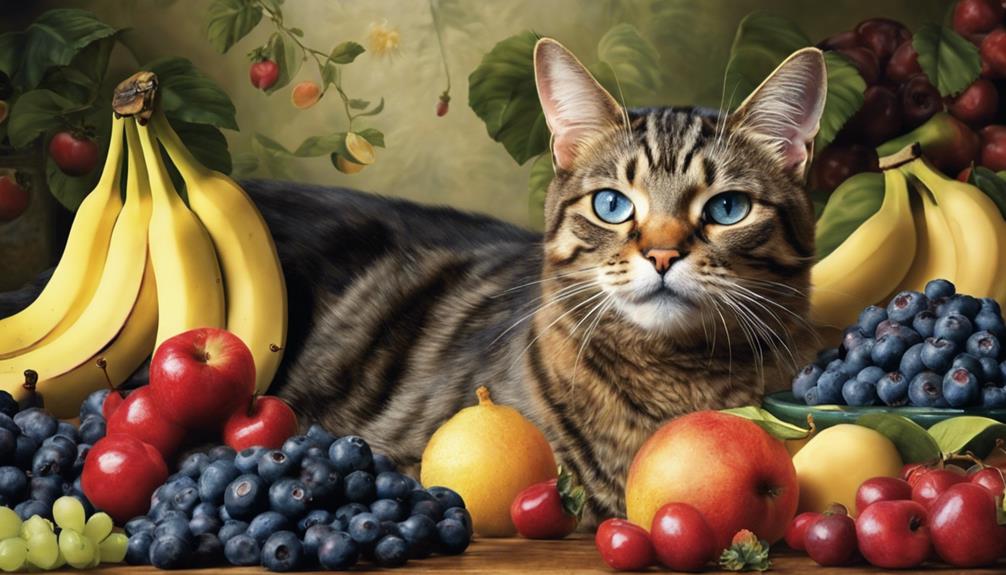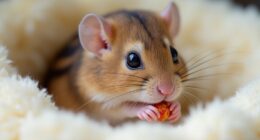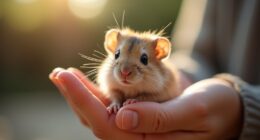Cherries are not safe for cats because they contain cyanide in the stems, leaves, and pits. Cyanide is not tolerated by cats, which can lead to severe poisoning symptoms. Eating cherry pits may result in intestinal blockages, requiring immediate surgery. Cyanide in parts of cherries can be harmful to cats when broken down. It is crucial to seek prompt veterinarian treatment if cherry ingestion is suspected. Opt for safer fruits like blueberries, strawberries, and apples instead. Avoid giving cherries to cats to ensure their health. Educate yourself about the risks associated with cherry pits and their impact.
Key Takeaways
- Cherries contain cyanide harmful to cats, leading to severe poisoning.
- Cyanide in cherry pits can cause intestinal obstruction, requiring surgery.
- Safe fruit alternatives for cats include blueberries, strawberries, and apples without seeds.
- Black cherries and cherry jam pose serious health risks to cats.
- Immediate vet attention is crucial if cherry ingestion is suspected to prevent complications.
Potential Risks of Cherries for Cats
What dangers do cherries pose to cats, and why should feline owners be cautious when it comes to these fruits?
When it comes to cats, cherries can be a serious threat due to the presence of cyanide in parts like the stems and pits. Cats are highly sensitive to cyanide, which can lead to severe poisoning if ingested. Symptoms of cyanide poisoning in cats include dilated pupils, excessive panting, and vomiting, signaling a medical emergency.
Additionally, ingesting cherry pits can result in intestinal obstruction, requiring immediate surgical intervention to save the cat's life. It's critical for cat owners to understand the risks associated with cherries and make sure that their feline companions steer clear of these fruits to prevent any potential harm.
Toxicity of Cherry Stems in Cats

Cherry stems contain cyanogenic glycosides, which can be harmful to cats if ingested. Symptoms of cherry stem poisoning in cats include brick red mucous membranes, dilated pupils, difficulty breathing, panting, and shock.
If you suspect your cat has eaten cherry stems, contact your veterinarian immediately for proper treatment and guidance.
Cherry Stems: Harmful Effects
After ingesting cherry stems, cats may experience toxic effects due to the presence of cyanogenic glycosides in these plant parts. These compounds can lead to cyanide poisoning, which is extremely harmful to cats.
Even though consuming 1-2 cherry stems may not be immediately toxic, it's important to remember that these plants contain a risk factor for our feline friends. The cyanide present in cherry stems can pose a severe threat to cats' health.
As a result, it's best to prevent cats from ingesting any part of the cherry plant to avoid potential complications. Being mindful of what our curious companions have access to can help keep them safe and healthy.
Symptoms of Ingestion
Experiencing toxicity from ingesting cherry stems can lead to various symptoms in cats. If your feline friend has nibbled on cherry stems, watch out for signs like brick red mucous membranes, dilated pupils, difficulty breathing, panting, or even shock.
These symptoms may start showing within 12-24 hours and could worsen over the next few days. Remember, even though consuming 1-2 cherry stems mightn't be immediately toxic, it's best to be cautious.
The cyanogenic glycosides in cherry plants, including stems, leaves, and pits, contain traces of cyanide that can be harmful to our furry companions. Keep a close eye on your cat's health and consult a veterinarian if you notice any concerning symptoms after cherry ingestion.
Treatment for Poisoning
In cases of toxicity from ingesting cherry stems, immediate veterinary intervention is vital to mitigate potential harm to cats. When symptoms of poisoning such as brick red mucous membranes, dilated pupils, difficulty breathing, panting, or shock are observed, seeking urgent medical attention is essential.
The vet may induce vomiting to remove any remaining cherry stems from the cat's system and provide supportive care such as administering activated charcoal to absorb toxins. In severe cases, treatments like oxygen therapy or intravenous fluids might be necessary to stabilize your feline friend.
Symptoms of Cherry Ingestion in Cats

Symptoms of cherry ingestion in cats can include dilated pupils, panting, vomiting, and difficulty breathing. If your feline friend has ingested cherries, keep an eye out for brick red mucous membranes, shock, and signs of distress, as these could indicate cherry poisoning.
The effects of cherry ingestion might start showing within 12-24 hours and worsen over 3-4 days, so vital action is essential. Toxic reactions can occur if cats consume cherry pits, stems, or leaves, even in small amounts.
These symptoms serve as warning signs that your cat may have ingested something harmful, emphasizing the importance of preventing cherry consumption altogether. Remember, our furry companions can't always resist the temptation of human foods, so it's up to us to keep them safe from potential dangers like cherry poisoning.
Keep a close watch on your cat's behavior and seek veterinary help if you suspect cherry ingestion.
Severity of Cyanide in Cherry Plants

Cherry plants, including their stems, leaves, and pits, contain trace amounts of cyanide, which poses a toxic risk to cats. Cyanide is a dangerous compound that can have severe toxic effects on our feline friends if ingested. The cherry stems, in particular, harbor cyanogenic glycosides, which can release cyanide when metabolized by the body. Even though consuming 1-2 cherry stems is unlikely to be immediately toxic to cats, caution is essential due to the potential dangers associated with cyanide.
If a cat ingests cherry stems or any part of the cherry plant, it's important to monitor for symptoms of cyanide poisoning, such as brick red mucous membranes, dilated pupils, difficulty breathing, panting, and shock. These symptoms can manifest within 12-24 hours and worsen over 3-4 days, highlighting the importance of swift action. If you suspect your cat has ingested cherry stems or is displaying any signs of toxicity, seeking immediate veterinary attention is highly recommended to safeguard their well-being. Remember, it's better to be cautious when it comes to potential risks like cyanide in cherry plants.
Veterinary Advice for Cherry Ingestion

Seek immediate veterinary attention if your cat has ingested any part of a cherry plant to ensure their well-being and safety.
When it comes to cherry ingestion, it's important to act promptly to prevent any potential toxic effects on your feline friend. If your cat eats cherries or any part of the cherry plant, such as the stems or leaves, they may experience symptoms like dilated pupils and difficulty breathing due to the cyanogenic glycosides present in these plants.
These effects can manifest within 12-24 hours and escalate over 3-4 days, leading to serious issues like brick red mucous membranes, panting, and shock. While consuming 1-2 cherry stems is unlikely to be toxic, it's best to err on the side of caution and seek professional veterinary advice immediately.
Immediate Actions for Cherry Consumption

Upon noticing signs of cherry ingestion in a cat, immediate action is imperative to guarantee their well-being and prompt treatment if necessary. If your feline friend displays symptoms like dilated pupils, vomiting, panting, or distress after consuming cherries, contacting a veterinarian is essential.
Remember to bring a sample of the cherry your cat ingested for analysis. The vet may recommend additional tests such as blood work and might administer oxygen or IV fluids in severe cases of cherry poisoning. It's important to act swiftly and decisively to safeguard your cat's health and safety.
Prevention is key, so make sure to keep cherries and their parts out of your cat's reach. By staying alert to the signs of cherry poisoning and seeking professional help promptly, you can help your cat recover quickly. Remember, your veterinarian is there to assist you in providing the best care for your furry companion.
Cherry Seeds and Cat Safety

To guarantee the safety of your feline friend, it's vital to comprehend the dangers associated with cherry seeds and their potential harm to cats.
While cherries themselves can be a tasty treat for your cat in moderation, it's important to make sure they don't consume the seeds. Cherry seeds contain cyanide, a toxic compound that can be harmful to cats if ingested. Ingesting cherry seeds can lead to cyanide poisoning in cats, causing serious health issues.
These seeds not only pose a choking hazard but can also result in dangerous intestinal blockages. It's best to prevent cats from accessing cherry seeds, pits, stems, and leaves as they all contain cyanogenic glycosides, making them toxic to our furry companions.
Black Cherries and Feline Health

Black cherries pose a significant threat to feline health due to the presence of cyanide in their pits, stems, and leaves. Cyanide poisoning from black cherries can lead to symptoms like dilated pupils, difficulty breathing, and shock in cats. Feeding black cherries to our furry friends can result in serious health risks, making it essential to avoid offering these toxic fruits to them.
It's important to steer clear of black cherry jam or any products containing black cherries to prevent toxicity in our beloved feline companions. Instead, opt for safer alternatives like blueberries or cat-friendly treats to keep our cats healthy and happy.
Cherry Jam and Cat Consumption

Cherry jam can be harmful to our feline pals because of its high sugar content and potential additives that aren't safe for cats. Giving cats cherry jam may result in digestive issues, obesity, and other health concerns, so it's best to steer clear of this sweet treat for our furry friends.
To guarantee our cats' well-being, it's important to avoid feeding them cherry jam and opt for safer treats that won't pose risks to their health.
Cherry Jam Caution
With its high sugar content and potential additives, cherry jam poses risks to cats and should be avoided in their diet. While a small amount of fresh cherries might be okay, cherry jam is another story.
The high sugar levels can lead to obesity and dental issues in our feline friends. Additionally, those sneaky additives in cherry jam could upset their delicate digestive systems. It's essential to steer clear of offering cherry jam to our cats as it doesn't offer any nutritional value to them.
Opting for cat-friendly treats is a much safer bet to keep our furry companions healthy and happy. Remember, when it comes to cherry jam, it's a big no-no for our purring pals!
Cats and Sweet Treats
Let's highlight the importance of being careful with sweet treats when it comes to our feline friends, particularly in the case of cherry jam.
While we may enjoy indulging in cherry jam on toast or pastries, it's essential to remember that cats have different dietary needs. Cherry jam contains high sugar levels and additives that aren't safe for cats.
To keep our furry companions healthy and happy, it's best to steer clear of offering them this sweet treat. Instead, opt for cat-friendly snacks that are safe for cats to consume.
Kitty Health Risks
Highlighting the potential health risks for felines, consuming cherry jam can lead to various digestive issues and allergic reactions. Cherry pits and stems contain compounds that are toxic to cats, potentially causing poisoning if ingested. These harmful parts can lead to gastrointestinal problems, including blockages or irritation.
Additionally, the high sugar content and additives in cherry jam can result in obesity and other health issues for your furry friend. It's important to avoid feeding cherry jam to cats to prevent unnecessary health risks and safeguard their well-being. Opt for cat-friendly treats and foods specifically formulated to meet your pet's nutritional needs and keep them safe from potential dangers associated with human foods like cherry jam.
Impact of Cherries on Cats

Cherries pose a significant danger to cats due to the presence of cyanide in their stems, leaves, and pits, which can lead to toxicity and serious health complications. Cats are curious creatures, and their interest in cherries may put them at risk of poisoning. If a cat ingests any part of a cherry, such as the stem, leaf, or pit, it can result in cyanide poisoning. This toxic substance can cause symptoms like dilated pupils, panting, and vomiting, indicating an essential life-threatening situation.
Ingesting cherry pits is especially hazardous as it can lead to intestinal obstruction, requiring immediate surgical intervention to prevent further harm. Hence, it's vital to keep cherries out of reach of your feline companions to avoid any accidental ingestion. If you suspect that your cat has consumed cherries or any of their parts, seeking prompt veterinary assistance or contacting a pet poison control hotline is necessary for timely intervention and proper care.
Cherry Alternatives for Cats

When contemplating safe fruit options for cats, it's important to explore alternatives such as blueberries, strawberries, and apples without seeds. These fruits offer a practical solution for cat owners looking to provide their feline friends with a tasty and healthy treat. Blueberries are filled with antioxidants, strawberries are abundant in vitamin C, and apples without seeds offer fiber—all without the risks associated with cherries. Opting for these cat-friendly options guarantees that your pet stays safe and satisfied.
It's vital to remember that fruits like melon and bananas can also be given to cats as an occasional treat, but in moderation due to their calorie content. Always prioritize fruits that are safe for cats over those that may pose a risk, such as cherries with their small parts that can be harmful to your furry companion. Before introducing any new fruits into your cat's diet, consulting your vet is a wise move to make sure you're making the right choices for your beloved pet's well-being.
Cat-Friendly Fruit Options

When it comes to choosing fruits for your feline friend, opt for safe options like apples, blueberries, and strawberries, which can be given as occasional treats.
However, be cautious with fruits like cherries that may not be suitable for cats due to potential toxicity.
Safe Fruits for Cats
While cats should primarily consume a diet geared towards their carnivorous nature, some fruits, such as apples, blueberries, and strawberries, can be safe occasional treats for them. These fruits are safe for cats in small parts, offering a tasty and healthy alternative to their regular diet. Other options like melon and bananas can also be given sparingly due to their calorie content. Remember, consulting your vet before introducing any new foods to your cat, especially if they have health issues, is crucial. Fruits should not be a regular part of a cat's diet because of their high sugar content, but offering safe fruits occasionally can add some variety and enjoyment to your feline friend's diet.
| Safe Fruits for Cats | Benefits |
|---|---|
| Apples (no seeds) | Rich in fiber and vitamin C |
| Blueberries | Packed with antioxidants |
| Strawberries | High in vitamin C and manganese |
| Melon, Bananas | Can be given sparingly due to calorie content |
Toxic Fruits to Avoid
Every now and then, cherries can be alluring to cats, but it's important to know that cherries, including their stems, leaves, and pits, are toxic to our feline friends due to the presence of cyanide.
As responsible cat owners, we must be mindful of other toxic fruits to avoid, such as grapes, raisins, and avocado. These fruits can cause serious health issues for our beloved pets.
The cherry pit, in particular, contains cyanogenic compounds that can be harmful if ingested by cats. To guarantee the safety of our furry companions, it's vital to stick to cat-friendly fruit options like seedless apples, blueberries, and strawberries.
While melon and bananas can be occasional treats, moderation is key, and consulting a vet before introducing any new fruits is always a wise decision.
Cherry Complications in Cats

Cherry complications in cats arise from the presence of cyanide in various parts of the cherry fruit. Cyanide, found in cherry stems, leaves, and pits, can result in cherry poisoning in cats. Symptoms of cherry poisoning include dilated pupils, panting, vomiting, and in severe cases, shock.
If a cat ingests cherry pits, there's a risk of intestinal obstruction, which may necessitate emergency veterinary intervention, possibly even requiring surgical treatment. Due to the high toxicity risk associated with cherries, it's best to prevent cats from consuming them altogether.
If you suspect your feline friend has eaten cherries or any part of the cherry plant, seeking immediate veterinary advice is essential. Remember, prompt action can make a significant difference in the outcome for your cat's health. Prioritize their well-being by keeping cherries out of their reach and opting for safer treats to guarantee their safety and happiness.
Safety Measures for Cat Diet

To guarantee the well-being of our feline companions, it's important to carefully consider the safety measures in their diet. When it comes to what our cat eats, it's essential to understand the potential risks of certain foods like cherries.
Parts of the cherry, such as the pits, stems, and leaves, contain cyanide, which can be harmful and even fatal to cats. Even ripe and seedless cherries pose risks, so it's best to steer clear and opt for safer alternatives like blueberries.
While cherries may offer health benefits to humans, they aren't suitable for our furry friends. As responsible pet owners, we must prioritize a balanced diet for our cats, steering clear of foods that can be harmful to them.
Consulting a veterinarian for advice on suitable cat foods is necessary to ensure the health and well-being of our beloved feline companions. By being mindful of what we feed our cats, we can help them lead long, healthy lives.
Expert Insights on Cherry Risks

When it pertains to cherries and cats, it's crucial to be mindful of the risks involved. Cherry pits can present dangers due to their cyanide content, potentially leading to toxicity in felines.
To ensure the safety of your cat, it's advisable to avoid cherries completely and choose safer alternatives in their diet.
Cherry Pit Dangers
As experts caution about the risks associated with cherry pits, it becomes important to grasp the potential dangers they pose to cats. Cherry pits contain cyanide, a toxic substance that can lead to intestinal obstruction if ingested by cats.
Ingesting these pits can result in symptoms such as vomiting and abdominal pain in our furry friends. It's vital to make sure that cats never have access to cherry pits, as chewing or swallowing them can have serious consequences.
If you suspect your cat has ingested a cherry pit, immediate veterinary attention is necessary. Remember, prevention is key to keeping our beloved feline companions safe and healthy, so always be cautious about what they've access to.
Toxicity Concerns
Understanding the potential risks associated with cherry toxicity in cats is essential for ensuring their well-being. Cherries contain cyanide in parts like stems, leaves, and pits, making them toxic to our feline friends. If a cat ingests these parts, symptoms of cyanide poisoning may appear, such as dilated pupils, panting, and vomiting. Ingesting cherry pits could even lead to intestinal obstruction, necessitating emergency surgery. Due to the high risk of toxicity concerns, it's best to keep cherries away from cats altogether. If you suspect your cat has consumed any part of a cherry plant, contact a vet or pet poison control immediately for assistance. Remember, a little knowledge about toxicity concerns can go a long way in safeguarding your cat's health.
| Toxicity Concerns | |
|---|---|
| Cyanide Poisoning | Dilated Pupils |
| Panting | |
| Vomiting |
Safe Alternatives for Cats
Exploring safe fruit alternatives for cats is important to avoid potential risks associated with cherry toxicity. Cats should steer clear of cherries due to the cyanide content in stems, leaves, and pits, which can lead to symptoms like dilated pupils and gastrointestinal issues.
Opting for cat-friendly foods like blueberries, apples (without seeds), and strawberries can be a vital and guaranteeing choice for your feline friend. Before introducing any new fruits into your cat's diet, it's essential to consult a vet to verify their safety.
Frequently Asked Questions
What Happens if a Cat Eats Cherries?
If a cat eats cherries, it risks cyanide poisoning from cherry pits, stems, or leaves. Symptoms like dilated pupils and panting may appear. Cherry pits can cause intestinal blockages, requiring urgent surgery. Cats should never have cherries to avoid health risks.
How Many Cherry Pits Are Toxic to Cats?
One cherry pit can be enough to harm a cat due to cyanide presence. It's important to keep these pits away. Seek immediate vet help if ingestion occurs to prevent serious health issues.
What Fruit Can Cats Not Eat?
Some fruits cats should avoid include grapes, raisins, onions, garlic, chocolate, citrus fruits, tomatoes, raw meat, fish, eggs, milk, and dairy products. Feeding them human food can lead to health issues, so stick to cat food.
What Berries Are Toxic to Cats?
Berries toxic to cats include grapes, raisins, and cherries due to cyanide in the stems, leaves, and pits. We must keep these away from curious cats to avoid poisoning. If ingestion occurs, contact a vet immediately.
Are There Any Fruits that Cats Can Eat Safely, like Cherries?
Not all fruits are safe for cats, and cherries are no exception. Cats and peanut butter safety can be a concern as well. It’s best to avoid feeding cats cherries or peanut butter, as they can be toxic to cats and may cause digestive issues. Stick to cat-safe treats instead.
Conclusion
To sum up, it's best to steer clear of giving cherries to your feline friends due to the potential risks they pose. Did you know that just one cherry pit contains enough cyanide to be harmful to a cat?
Remember, keeping your furry companions safe and healthy should always be a top priority when it comes to their diet. Stick to cat-friendly fruits like apples and blueberries to make sure they stay happy and well-nourished.










